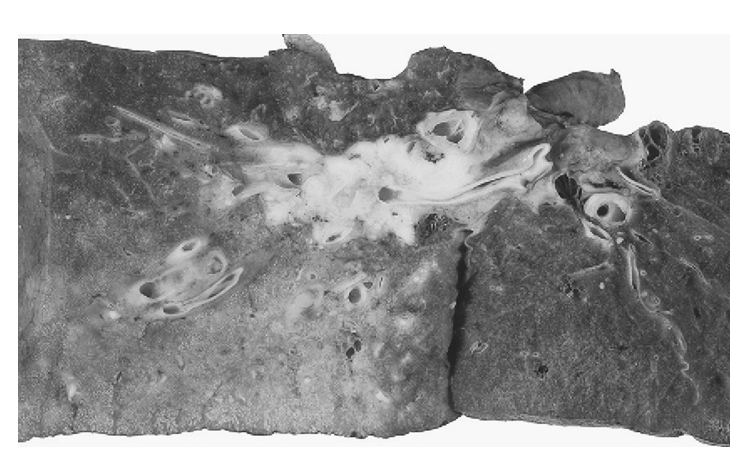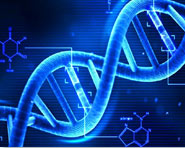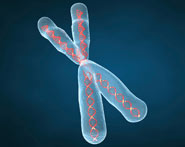


 النبات
النبات
 الحيوان
الحيوان
 الأحياء المجهرية
الأحياء المجهرية
 علم الأمراض
علم الأمراض
 التقانة الإحيائية
التقانة الإحيائية
 التقنية الحيوية المكروبية
التقنية الحيوية المكروبية
 التقنية الحياتية النانوية
التقنية الحياتية النانوية
 علم الأجنة
علم الأجنة
 الأحياء الجزيئي
الأحياء الجزيئي
 علم وظائف الأعضاء
علم وظائف الأعضاء
 الغدد
الغدد
 المضادات الحيوية
المضادات الحيوية|
Read More
Date: 2025-02-08
Date: 2025-01-25
Date: 2025-04-08
|
Definition
• A malignant epithelial tumour arising in the lung.
Epidemiology
• One of the most common and deadly cancers with nearly 2 million deaths annually. • Most present in patients aged over 60 years.
Aetiology
• About 80% of cases are directly attributable to smoking.
Classification
• Adenocarcinoma (40%).
• Squamous cell carcinoma (20%).
• Small cell carcinoma (15%).
• A number of rare subtypes make up the remainder.
Carcinogenesis
• Similar to other carcinomas, lung carcinomas are likely to arise from a precursor phase of epithelial dysplasia, representing neoplastic transformation of lung epithelium without invasion.
• Adenomatous dysplasia/adenocarcinoma in situ precedes adenocarcinoma.
• Squamous dysplasia/ squamous carcinoma in situ precedes squamous cell carcinoma.
Genetic mutations
• Adenocarcinoma: Gain of function mutations in receptor tyrosine kinase genes such as EGFR, ALK, ROS, and MET.
• Squamous cell carcinoma: Loss of function mutations in tumour suppressor genes such as TP53 and CDKN2A.
• Small cell carcinoma: Inactivation of TP53 and RB; amplification of MyC family.
Presentation
• Symptoms related to local growth of the tumour include progressive breathlessness, cough, chest pain, hoarseness, or loss of voice, haemoptysis, weight loss, and recurrent pneumonia.
• Abdominal pain, bony pain, and neurological symptoms may occur from metastases.
• A small proportion of small cell carcinomas present with paraneoplastic syndromes or the superior vena cava syndrome.
Macroscopy
• A firm white/ grey tumour mass within the lung.
• yellow consolidation may be seen in the lung parenchyma distal to large proximal tumours due to an obstructive pneumonia (Fig.1).
• Pleural puckering may be seen overlying peripheral tumours that have infiltrated the pleura.
• Metastatic tumour deposits may be seen in hilar lymph nodes.

Fig.1 A central lung carcinoma. note how the lung tissue distal to the tumour shows flecks of yellow consolidation due to an obstructive pneumonia. the tumour was found to be a squamous cell carcinoma when examined microscopically. Reproduced with permission from Clinical Pathology (Oxford Core texts), Carton, James, Daly, Richard, and Ramani, Pramila, Oxford University Press (2006), p.131, Figure 7.13.
Histopathology
• Adenocarcinoma: malignant epithelial tumour showing glandular differentiation and/ or mucin production.
• Squamous cell carcinoma: malignant epithelial tumour showing keratinization and/ or intercellular bridges.
• Small cell carcinoma: high grade neuroendocrine carcinoma composed of small cells with scant cytoplasm, ill- defined cell borders, finely granular chromatin, and absent nucleoli. Mitotic activity is high and necrosis is often extensive.
Immunohistochemistry
• the main histological types of lung carcinomas show differing patterns of immunohistochemistry which can aid in diagnosis.
• Adenocarcinoma: p63/ p40 negative; TTF1 positive.
• Squamous cell carcinoma: p63/ p40 positive; TTF1 negative. • Small cell carcinoma: neuroendocrine marker (CD56, chromogranin, synaptophysin) positive; TTF1 positive.
Prognosis
• Poor with 5- year survival rates of ~10% in most countries.



|
|
|
|
التوتر والسرطان.. علماء يحذرون من "صلة خطيرة"
|
|
|
|
|
|
|
مرآة السيارة: مدى دقة عكسها للصورة الصحيحة
|
|
|
|
|
|
|
نحو شراكة وطنية متكاملة.. الأمين العام للعتبة الحسينية يبحث مع وكيل وزارة الخارجية آفاق التعاون المؤسسي
|
|
|